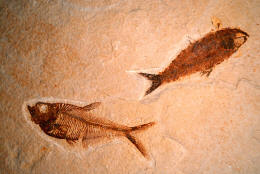|
Konservat-Lagerstätten (conservation Lagerstätten) are
deposits known for the exceptional preservation of fossilized organisms,
where the soft parts are preserved in the form of impressions or casts. This
is caused by incompleteness of biological recycling, for example where
anoxic conditions, as in oxygen-free mud, has suppressed common
bacterial decomposition long enough for the initial casts of soft body
parts to register. The individual
taphonomy
of the fossils varies with the sites. Conservation Lagerstätten are crucial
in providing answers to important moments in the history and
evolution
of life, for example the
Burgess Shale of British Columbia is associated with the
Cambrian explosion, and the
Solnhofen limestone with the earliest known
bird,
Archaeopteryx.
Konservat-Lagerstätten preserve lightly
sclerotized (hardened tissue) and soft-bodied organisms that are not otherwise preserved
in the usual shelly and bony fossil record; thus they offer a more complete
record of ancient biodiversity and enable some reconstruction of the
palaeoecology of ancient aquatic communities. In 1986
Simon Conway Morris calculated that only about 14% of genera in the
Burgess Shale had possessed
biomineralized tissues in life. The affinities of the shelly elements of
conodonts
were mysterious until the associated soft tissues were discovered near
Edinburgh, Scotland, in the Granton Lower
Oil Shale of the
Carboniferous.
Information from the broader range of organisms found in Lagerstätten have
contributed to recent
phylogenetic reconstructions of some major
metazoan groups.
Cambrian Rock Layer - The Burgess Shale
The Burgess Shale Formation — located in the
Canadian Rockies of
British Columbia — is one of the world's most celebrated fossil fields,
and the best of its kind.
It is famous for the exceptional preservation of the soft parts of its
fossils. It is
505 million years
old(Middle
Cambrian).
The rock unit is a black
shale, and
crops out at a number of localities near the town of
Field in the
Yoho National Park.
History and
Significance
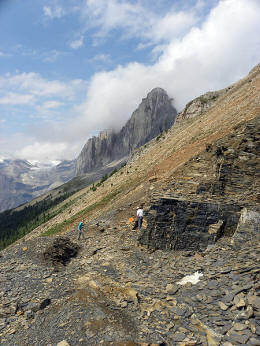 |
Above: Walcott Quarry of the Burgess Shale showing the Walcott Quarry
Shale Member
Below: Charles Walcott searching for fossils, with
his wife and son. |
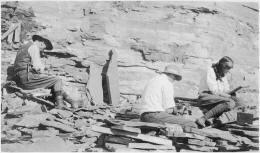 |
The Burgess Shale was discovered by
palaeontologist
Charles Walcott in 1909, towards the end of the season's fieldwork.
He returned in 1910 with his sons, establishing a quarry on the flanks of
Fossil Ridge. The significance of soft-bodied preservation, and the range of
organisms he recognised as new to science, led him to return to the quarry
almost every year until 1924. At this point, aged 74, he had amassed over
65,000 specimens. Describing the fossils was a vast task, pursued by Walcott
until his death in 1927.
Walcott, led by scientific opinion at the time, attempted to categorise all
fossils into living taxa, and as a result, the fossils were regarded as
little more than curiosities at the time. It was not until 1962 that a
first-hand reinvestigation of the fossils was attempted, by Alberto
Simonetta. This led scientists to recognise that Walcott had barely
scratched the surface of information available in the Burgess Shale, and
also made it clear that the organisms did not fit comfortably into modern
groups.
Excavations were resumed at the Walcott quarry by the Geological Survey
of Canada under the persuasion of
trilobite
expert
Harry Blackmore Whittington, and a new quarry, the Raymond, was
established about 20 meters higher up Fossil Ridge.
Whittington, with the help of research students of the
University of Cambridge, began a thorough reassessment of the Burgess
Shale, and revealed that the fauna represented were
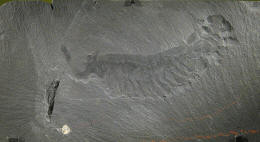 |
Above: Typical flattened Burgess Shale fossil (Opabinia)
Below: Opabinia artist rendition |
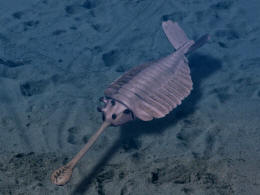 |
much more diverse and
unusual than Walcott had recognized.
Indeed, many of the animals present had
bizarre anatomical features and only the sketchiest resemblance to other
known animals. Examples include
Opabinia,
with five eyes and a snout like a vacuum cleaner hose;
Nectocaris, which resembles either a
crustacean with fins or a
vertebrate with a shell; and
Hallucigenia, which was originally reconstructed upside down,
walking on bilaterally symmetrical spines.
With
Parks Canada and
UNESCO
recognising the significance of the Burgess Shale, collecting fossils became
politically more difficult from the mid-1970s. Collections continued to be
made by the
Royal Ontario Museum. The curator of invertebrate palaeontology,
Desmond Collins, identified a number of additional outcrops,
stratigraphically both higher and lower than the original Walcott quarry.
These localities continue to yield new organisms faster than they can be
studied.
Stephen Jay Gould's book
Wonderful Life, published in 1989, brought the Burgess Shale fossils
to the public's attention. Gould suggests that the extraordinary diversity
of the fossils indicate that life forms at the time were much more diverse
than those that survive today, and that many of the unique lineages were
evolutionary experiments that became extinct. Gould's interpretation of the
diversity of Cambrian fauna relied heavily on Simon Conway Morris'
reinterpretation of Charles Walcott's original publications. However, Conway
Morris strongly disagreed with Gould's conclusions, arguing that almost all
the Cambrian fauna could be classified into modern day phyla.
Geological
Setting
The fossiliferous deposits of the Burgess Shale correlate to the
Stephen Formation, a collection of slightly calcareous dark mudstones,
about
505 million years old. The beds were deposited at the base of a cliff
about 160 m tall, below the depth agitated by waves during storms. This
vertical cliff was composed of the calcareous reefs of the Cathedral
Formation, which probably formed shortly before the deposition of the
Burgess Shale. The precise formation mechanism is not known for certain, but
the most widely accepted hypothesis suggests that the edge of the Cathedral
Formation reef became detached from the rest of the reef, slumping and being
transported some distance — perhaps kilometers — away from the reef edge.
Later reactivation of faults at the base of the formation led to its
disintegration from about
509 million years ago. This would have left a steep cliff, the bottom
of which would be protected, because the limestone of the Cathedral
Formation is difficult to compress, from tectonic decompression. This
protection explains why fossils preserved further from the Cathedral
Formation are impossible to work with — tectonic squeezing of the beds has
produced a vertical cleavage that fractures the rocks, so they split
perpendicular to the fossils. The Walcott quarry produced such spectacular
fossils because it was so close to the Stephen Formation — indeed the quarry
has now been excavated to the very edge of the Cambrian cliff.
It was originally thought that the Burgess Shale was deposited in anoxic
conditions, but mounting research shows that oxygen was continually present
in the sediment. The anoxic setting had been thought to not only protect the
newly dead organisms from decay, but it also created chemical conditions
allowing the preservation of the soft parts of the organisms. Further, it
reduced the abundance of burrowing organisms — burrows and trackways are found in
beds containing soft-bodied organisms, but they are rare and generally of
limited vertical extent.
Brine seeps are an alternative hypothesis - see
Burgess Shale type preservation for a more thorough discussion.
Taphonomy and
Diagenesis
There are many other comparable Cambrian
lagerstätten; indeed such assemblages are far more common in the
Cambrian than in any other period. This is mainly due to the limited extent
of burrowing activity; as such
bioturbation
became more prevalent throughout the Cambrian, environments capable of
preserving organisms' soft parts became much rarer.
(The
pre-Cambrian fossil record of animals is sparse and ambiguous.)
Biota
The biota of the Burgess Shale appears to be typical of Middle Cambrian
deposits.
Although the hard-part bearing organisms make up as little as 14% of the
community,
these same organisms are found in similar proportions in other Cambrian
localities. This means that there is no reason to assume that the organisms
without hard parts are exceptional in any way; indeed, many appear in other
lagerstätten of different age and locations.
The biota consists of a range of organisms. Free-swimming (nectonic)
organisms are relatively rare, with the majority of organisms being bottom
dwelling (benthic) — either moving about (vagrant) or permanently attached
to the sea floor (sessile).
About two-thirds of the Burgess Shale organisms lived by feeding on the
organic content in the muddy sea floor, while almost a third filtered out
fine particles from the water column. Under 10% of organisms were predators
or scavengers, although since these organisms were larger, the biomass was
split equally between each of the filter feeding, deposit feeding, predatory
and scavenging organisms.
|
